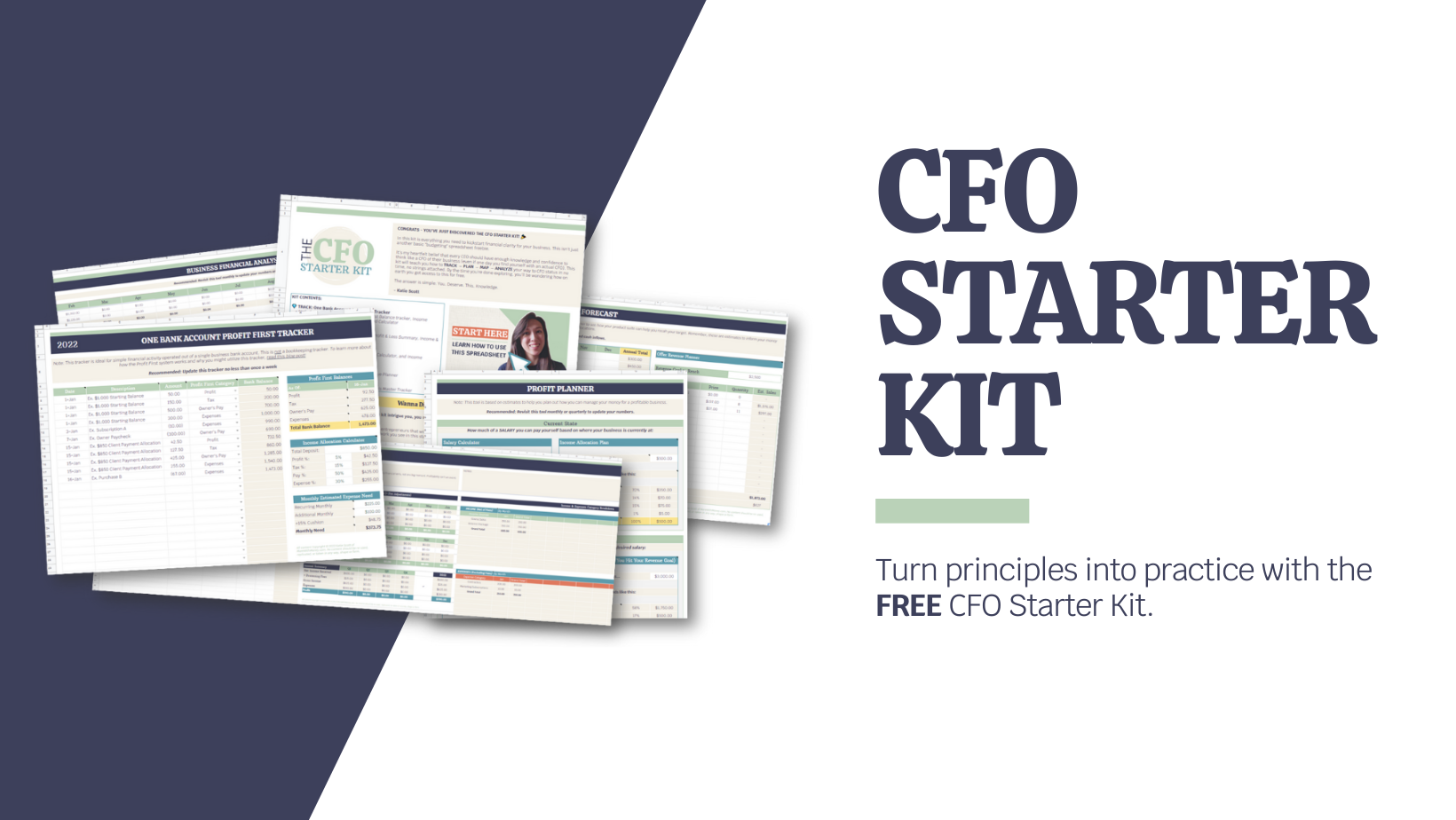How to Analyze Business Growth Like a CFO
So you’re growing a business and have had some success...now what? If you're not intentional about recreating success, leveraging momentum, and pivoting when things aren't working, you're not analyzing your business growth like a CFO. In this post, we'll discuss how to measure your performance and reflect on it critically to make better decisions for the future.
This is Part 3 of 3 in the CFO Habits Series!
The Value of CEO Analysis
Many entrepreneurs struggle with finding the time to work on their business (versus in). We get caught up in creating products and serving clients and we neglect some of the necessary tasks for nurturing and refining our businesses.
Taking the time to actually be the CEO of your business is critical for long-term growth and success, which is why I recommend designating at least one day a month to your CEO Day tasks - including conducting a thorough analysis of your business’ performance.
The CEO Day Routine
On the first workday of every new month, I try to block a few hours exclusively for my CEO Day Routine. Not only is this where I handle my bookkeeping and revenue planning, but it’s also where I like to complete other CEO-type tasks!
I find that blocking this time is what allows me to spend time:
Analyzing my business numbers (financial and otherwise!)
Making new plans and goals for the upcoming month and/or quarter
Reflecting on and re-aligning with my vision for my business
Wrapping up any loose-end tasks I’ve been putting off
Whatever else tends to fall to the wayside when I’m too busy working in my business
One of my favorite parts of my CEO Day involves updating my Analysis spreadsheet. This is a tool that I created to take note of important numbers from month to month, which makes it super easy to see my business growth over time from a bird’s eye view.
A starting template like this can be found inside the free CFO Starter Kit! The basic idea is to have a column for each month of the year, with year-end totals (or averages) calculated in the last column. In the rows below, you can decide which metrics or notes you want to track for every single month throughout the year.
Data & Metrics to Track
A huge component of conducting a thorough analysis of your business’ performance is TRACKING. Ideally, you’d have a financial tracking system - one that both involves traditional bookkeeping but also keeps track of your business’ available funds for various purposes (taxes, paying yourself, savings, and expenses).
Click here to read: Track Business Finances Like a CFO (+ the Step Everyone Misses)
With a financial tracking system, you should be able to track at a minimum your:
Total Revenue
Total Expenses
Net Profit or Loss
You may also want to track some other financial metrics such as:
How much you paid yourself
How much you saved (in general and/or for a specific purpose)
How much debt you paid off
How much was spent on a particular purpose (such as an intentional investment where you want to track your return on that investment)
How much revenue came from a particular income stream
But there’s even more that you can track! Your business performance is about more than just the finances. Some other types of data I’ve tracked in the past (depending on what was important to me in that season):
Sales calls conducted vs. closed
Website analytics (visitors, traffic sources, bounce rates, etc)
Social media analytics (# of posts, average engagement, reach, clicks to website, etc)
Email marketing analytics (open rates, click rates, unsubscribe rates, new subscribers, etc)
Amount of guest appearances (such as guest interviews, guest blogs, summits, etc. if this is a part of your visibility strategy)
Certain monthly tasks/priorities/goals completed
You get the idea! The key is to identify what’s important to you and how you can measure it. Once you have that, you can add it to your own growth tracker-type spreadsheet (or resource of choice) each month so that you can start using objective information to measure your progress.
But it doesn’t stop there! Tracking is only as valuable as the time you spend learning from the data. So let’s talk about analysis.
Analysis Prompts
The specific questions you ask yourself are going to depend on what metrics you’re tracking for your business, and what those metrics are. But here are some general prompts to get you started:
What business events happened this month? What personal events happened that might have impacted my business? What numbers/results do I see that reflect what happened?
What results am I happy to see? What contributed to this? How can I recreate this result again in the future?
How can I build off of the momentum I created with this win? How can I take it to the next level?
What results was I not as happy to see? What contributed to this? How can I correct this and prevent it from happening again in the future?
What lesson(s) did I learn this month? How can I immediately implement that lesson into the way I run my business?
Some of these may seem fairly straightforward. But I assure you that if you actually pause and take the time to intentionally answer questions like these for your business every month, the results will speak for themselves!
Intentionality makes all the difference in the success of not only your business but your LIFE. Taking the time to reflect and realign is the first step.
How to Start Analyzing Like a CFO
So here are the next steps to applying what you’ve learned in this post:
Brainstorm your top priorities that represent what success looks like for your business right now.
Identify how you can measure your progress with these priorities.
Download The CFO Starter Kit and customize the Analytics tool to start tracking your metrics.
Schedule time for a once-a-month CEO day to update your tracker and spend time doing your analysis.
Click here to read the rest of the CFO Habits Series here on the blog
Are you ready to take your financial journey to the next level? Then you may be ready to check out the More With Money Academy!
This ever-growing collection of online courses and trainings are specially designed to support entrepreneurs like you on your path to financial wellness. The Academy contains carefully designed courses that are easy to understand and implement so that you can be empowered with the practical concepts, streamlined systems, and powerful mindset to transform your business and personal finances.
Click here to explore what the More With Money Academy has to offer!
Pin for later
I'd love to continue the conversation in the comments! Feel free to share your thoughts.
Until next time!






